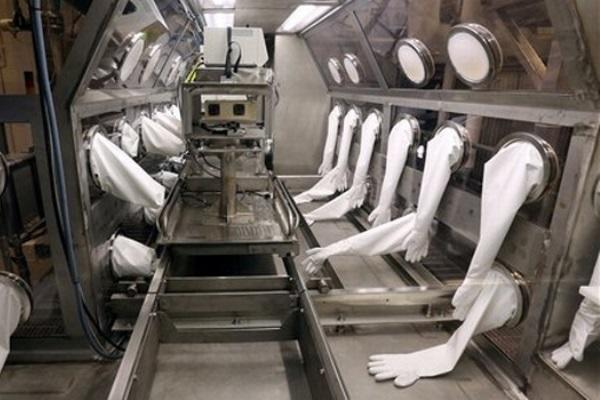The Pentagon added Japan Friday to the list of places that were sent live anthrax samples in the latest disclosure on the military's program for handling deadly pathogens that government reports and outside experts have called poorly managed and possibly unnecessary.
The Army's Dugway Proving Ground sent an anthrax sample in 2005 that had been irradiated and was supposed to be inert to the Army's Camp Zama south of Tokyo. The sample later was found to have live spores and was destroyed in 2009.
"When we sent it, we thought it was inactive," Army Col. Steve Warren, a Pentagon spokesman, said of the sample that went to Camp Zama by commercial shipment.
As with other suspect shipments, there was no threat to the general public, Warren said.
"It's important to note that there currently is no anthrax, activated or inactivated, in Japan at this time," Warren said.
Thus far, 31 persons working at the labs and bases have been taking the prophylaxis CIPRO as a precaution against possible exposure to anthrax. Twenty-two of those personnel, including 10 soldiers and five airmen, were at the Osan Air Force Base in South Korea.
The previously undisclosed shipment to Japan brought the currently known number of shipments from Dugway to civilian laboratories and military bases to 69 in 19 states, the District of Columbia and five countries – Japan, South Korea, Canada, Britain and Australia.
The states receiving live samples were identified as California, Utah, Texas, Tennessee, Virginia, Massachusetts, Wisconsin, Maryland, New Jersey, New York, Delaware, Washington, Illinois, Florida, Arizona, Ohio, North Carolina, Rhode Island and Pennsylvania.
It was not immediately clear whether the Japanese government had been aware of the presence of anthrax. In the case of South Korea, Defense Secretary Ashton Carter has apologized to his South Korean counterpart for the shipment of an anthrax sample to the Osan Air Force Base without telling the Seoul government.
21 of 22 Found Positive
The Centers for Disease Control and Prevention in Atlanta, which is investigating the military's anthrax program, has also now received 22 of the suspect shipments that were sent out and found that 21 were positive for live spores, Warren said.
In the course of the 10-year-old program, the military made commercial shipments, many by Federal Express, of both live and inert samples. The total number of shipments, and the list of labs and bases that received them, is not yet known.
"The numbers are in flux," Frank Kendall, the undersecretary of Defense for acquisition, said last week. Kendall has been appointed by Carter to conduct a 30-day review of the program.
In a Pentagon demonstration last week, Navy Cmdr. Franca Jones, the Pentagon's director of medical programs for biological defense, showed how small vials of liquid anthrax were packed in plastic containers and then put in cardboard boxes in dry ice for shipment.
The only difference in the method of shipment and packaging for live and inert samples was a label on the box indicating "live," she said.
The purpose of the shipments to federal and civilian labs and contractors was to gather input for improving detection methods and also to develop a field testing device for the military and possibly a better vaccine.
Some of the participants in the program were motivated by potential profit and worked to develop a detection device that they could then sell to the military, said Maj. Eric Badger, a Pentagon spokesman. Others were paid to participate, but the Pentagon has yet to determine how much money was spent over 10 years on the program, Badger said.
Accident Rate Rising
"Thus far, no conclusions have been drawn" on what went wrong in the oversight of the anthrax program by the military and the CDC, Warren said.
However, the non-partisan Government Accountability Office told Congress last year that the potential for accidents and sabotage was rising from the proliferating number of commercial, university and federal labs doing research on risky pathogens such as anthrax, smallpox and various strains of flu.
The GAO said the number of labs had grown from 400 in 2004 to more than 1,500, and oversight of the labs was "fragmented and largely self-policing."
In a report in 2013, the GAO noted the lack of accountability. "There is still no one agency or group that knows the nation's need for all U.S. high- containment laboratories, including the research priorities and the capacity, number and location, to address priorities," the GAO said.
In 2012, the CDC said the number of labs where accidents were reported involving microbes that could cause severe illness or death had increased from 16 in 2004 to 269 in 2010.
In addition, "there is absolutely no reason, none whatsoever" for the military to be shipping anthrax samples around the U.S. and the world, said Dr. Richard Ebright, head of the Waksman Institute of Microbiology at Rutgers University and a recognized authority in the field. "There is absolutely no justification for that activity."
In a phone interview, Ebright said that the testing on the anthrax samples could have been done with inert and safe simulants rather than a virulent strain to produce the same results.
"Any simulant is suitable," he said. "There is no reason to be distributing this to hundreds of labs, hundreds of contractors. It's just crazy."
Ebright made much the same argument last year for the use of non-virulent strains in testimony to the House Energy and Commerce Committee on failures by the CDC in its own handling of anthrax samples.
At the same hearing, Dr. Thomas Freiden, director of the CDC, said he also was concerned at the growing number of labs handling deadly toxins and the increasing risk of accidents. He said the number of such labs should be reduced to the "absolute minimum necessary."
-- Richard Sisk can be reached at richard.sisk@military.com






























